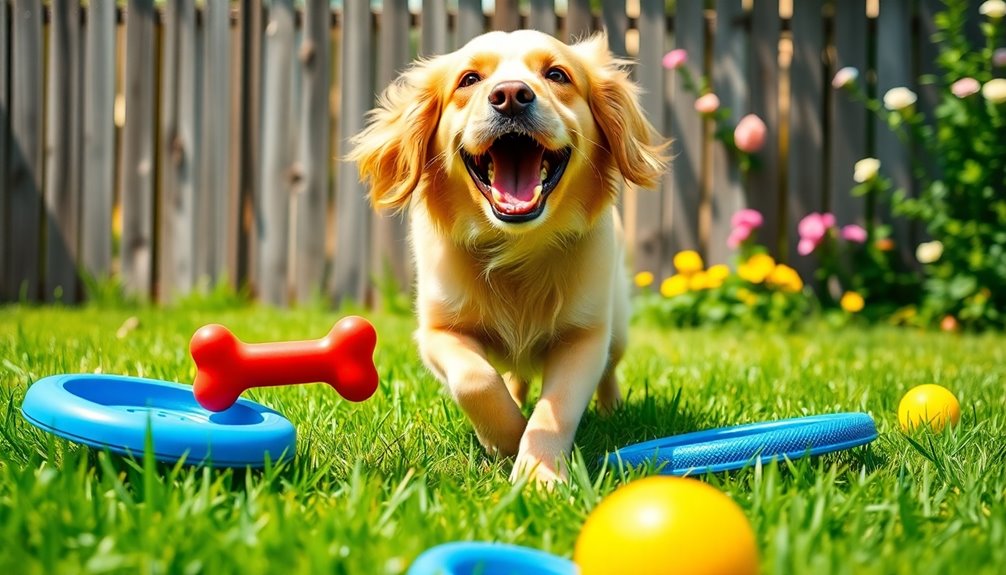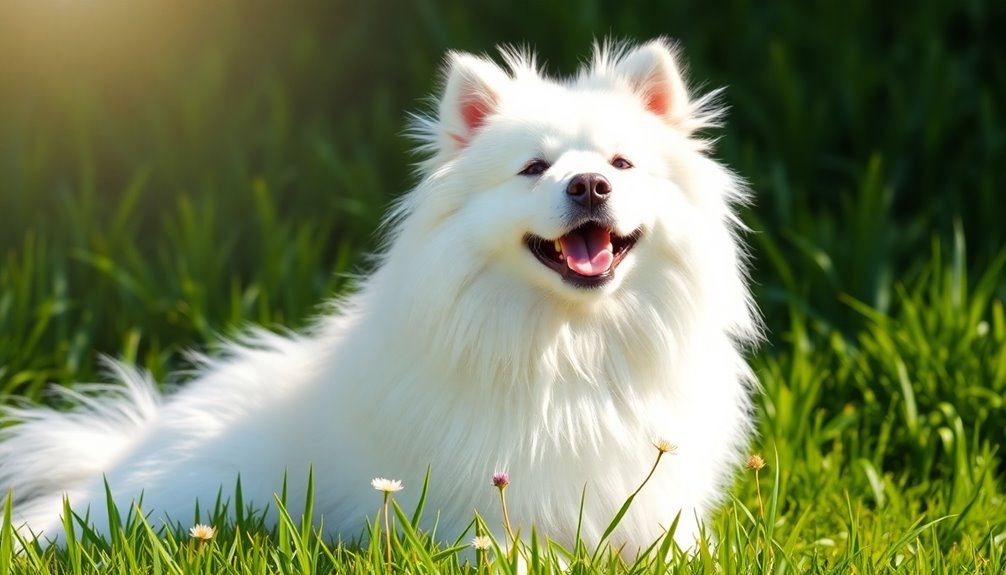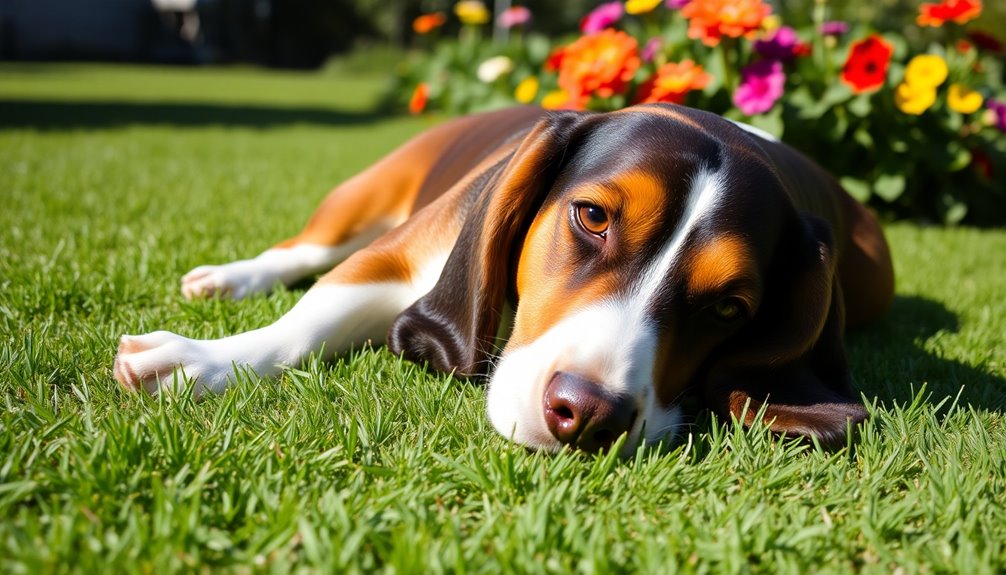The graceful Irish Setter is a fascinating breed with a striking red coat and friendly demeanor. They thrive on social interaction and require regular exercise, making them perfect companions for active families. With a medium to large size, these dogs need grooming every few months to maintain their beautiful coats. While they're generally good with kids and other pets, early training and socialization are essential. They have a lifespan of 12 to 15 years and can face health concerns, so responsible breeding is vital. Explore more about their unique traits and care needs for a fulfilling experience with an Irish Setter.
Key Takeaways
- The Irish Setter, originating in Ireland, is known for its striking red coat and has a history dating back to the 16th century.
- Medium to large-sized, Irish Setters weigh 45 to 65 pounds and have a long, silky coat requiring regular grooming.
- They are playful, affectionate, and require daily exercise and socialization to manage their energetic temperament.
- Lifespan ranges from 12 to 15 years, with regular veterinary care essential to monitor for health issues like hip dysplasia and bloat.
- Ideal for active families, Irish Setters can adapt to various living environments with sufficient physical and mental stimulation.
Breed History and Origin

The Irish Setter boasts a rich history that stretches back to at least the 16th century in Ireland. This breed, one of the oldest among setting dogs, was developed primarily for hunting purposes. Early mentions of setting dogs in English texts hint at significant Irish influence, showcasing their role in the hunting scene.
You'll find that red spaniels were bred in Ireland specifically for their exceptional hunting abilities, which played a vital part in shaping the Irish Setter's development.
By the 1800s, the breed's distinct appearance, marked by its solid red coat, became widely recognized in paintings, solidifying its reputation as a high-quality hunting dog.
However, the breed history also reflects challenges. Socioeconomic events like the Irish Rebellion of 1798 and the potato famine adversely affected the Irish Setter's popularity. Additionally, from 1840 to 1880, increased interest in English Setters and Pointers posed further challenges to the breed's standing.
Despite these setbacks, the Irish Setter's origins in hunting and its striking red coat remain central to its identity, connecting you to a legacy that celebrates both beauty and functionality.
Physical Characteristics

When you look at an Irish Setter, you can't help but notice their impressive size and weight, typically ranging from 45 to 65 pounds.
Their long, silky coat showcases stunning colors like solid red, chestnut, or mahogany, adding to their striking presence.
With their lanky build and undocked tail, they exhibit both elegance and agility, making them a joy to watch in motion.
Size and Weight
Irish Setters are medium to large-sized dogs, typically weighing between 45 to 65 pounds. Males average around 60 pounds, while females are about 55 pounds. You'll notice that adult males stand approximately 26 to 28 inches tall at the shoulder, with females ranging from 24 to 26 inches. This height combined with their elegant build gives them an agile appearance, making the Irish Setter one of the more graceful dog breeds.
As a puppy, an Irish Setter's average weight at 6 months is around 38.5 pounds, but you'll see significant growth as they reach about 65.5 pounds by 18 months. Their long, undocked tails further enhance their graceful stature, complementing their striking red coats.
When you look at an Irish Setter, you're not just seeing a pet; you're witnessing a breed designed for both beauty and function. Their size and weight make them suitable for various activities, from hunting to companionship.
This combination of height and weight contributes to their overall presence, making them a beloved choice for many dog lovers.
Coat Color and Texture
With their impressive size and graceful stature, Irish Setters captivate not only with their physical presence but also with their stunning coat color and texture. Their striking solid red coat can range from deep mahogany to bright chestnut, offering a palette that's visually striking.
The long, silky fur enhances their elegant appearance, flowing smoothly and contributing to their athleticism.
To keep your Irish Setter looking their best, consider these grooming needs:
- Brushing: At least once a week to prevent matting and reduce shedding.
- Bathing: Every few months or as needed to maintain coat health and cleanliness.
- Feathering Care: Pay special attention to the feathering on their ears, legs, and tail, as it enhances their graceful silhouette.
With regular grooming, you'll not only keep their coat vibrant and healthy but also enjoy the bonding experience.
The silky texture and rich coat color truly make your Irish Setter stand out, blending practicality with beauty, ensuring they remain the center of attention wherever they go.
Temperament and Behavior
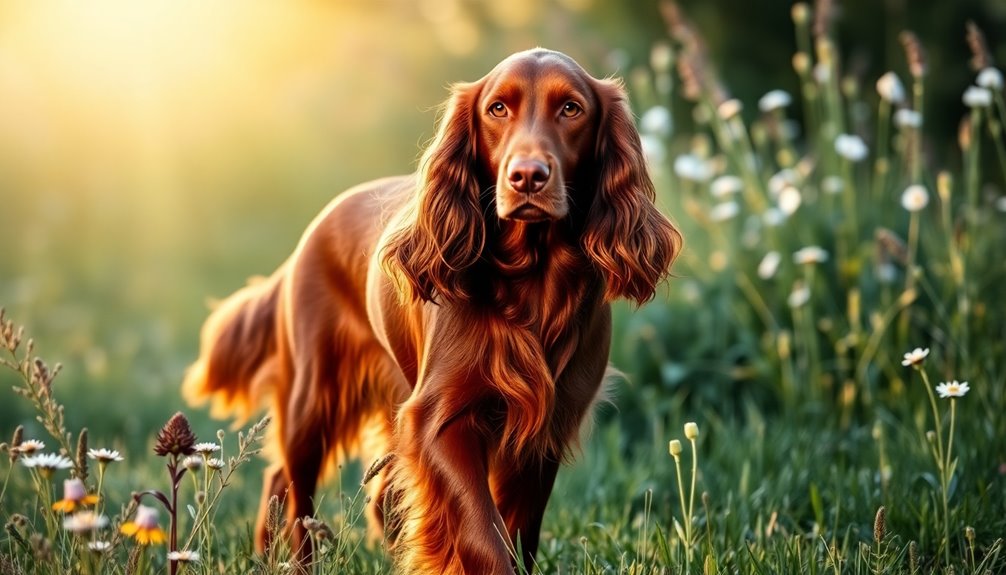
When you think about an Irish Setter's temperament, you'll notice their playful and affectionate nature shines through.
They thrive on socialization and training, which helps channel their energy positively and keeps them well-adjusted.
Understanding these traits is key to fostering a happy and harmonious relationship with your furry friend.
Playful and Affectionate Nature
Renowned for their friendly and outgoing nature, Irish Setters make exceptional companions for families and individuals alike. Their playful and affectionate demeanor fosters strong bonds with their owners, making them a joy to have around.
These energetic dogs thrive on attention and companionship, guaranteeing that your household is always filled with love and laughter.
To keep your Irish Setter happy and balanced, consider these three key aspects:
- Exercise: Regular outdoor activities are vital for channeling their exuberance. Daily walks, playtime, and fetch can help burn off that energy.
- Affection: Spend quality time with your Irish Setter. They crave interaction and respond positively to cuddles and praise, reinforcing your bond.
- Training: Early training is essential. It not only helps manage their strong prey drive but also sets the foundation for good behavior.
Socialization is equally important, as it encourages your dog to be well-adjusted around other pets and people.
Socialization and Training Needs
Socializing your Irish Setter early on is vital for managing their exuberant personality and ensuring they behave well around other pets and people. By exposing them to various environments, sounds, and faces, you help them develop confidence and reduce the likelihood of unwanted behaviors later on.
Training sessions should incorporate positive reinforcement techniques, as these dogs are highly trainable and respond well to rewards. Focus on teaching basic commands like sit, stay, and come to lay a solid foundation for good behavior.
Consistency is key, so make training part of your daily routine.
Due to their high energy levels, regular mental stimulation is essential to prevent boredom-related behaviors. Engage your Irish Setter with interactive toys, puzzles, and regular exercise to keep them happy and focused.
Health Considerations
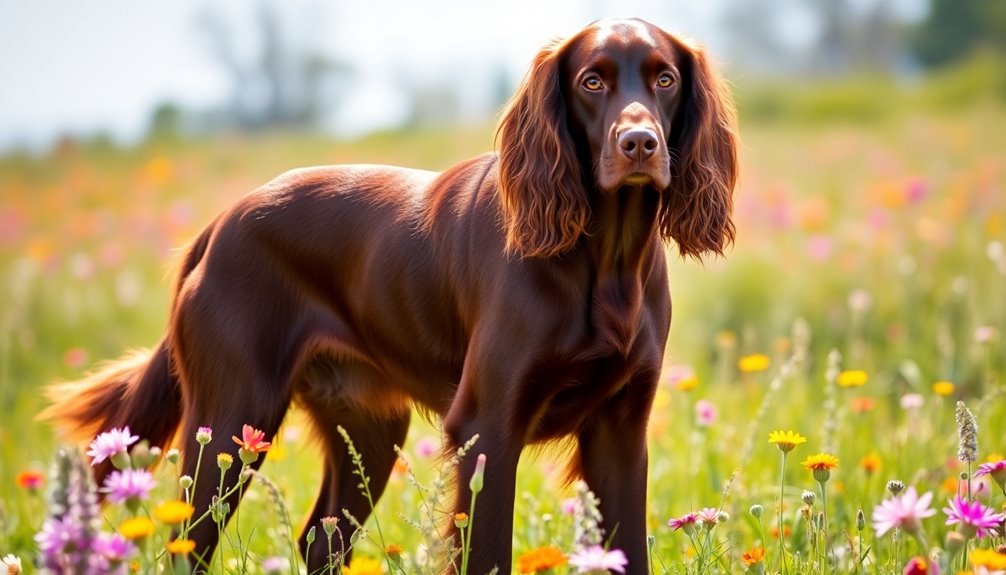
Many prospective owners of Irish Setters should be aware of important health considerations for this breed. While Irish Setters can live between 12 to 15 years, it's vital to monitor their health through regular veterinary check-ups. You should be particularly vigilant about common health issues, as this breed is prone to certain conditions.
Here are three key health considerations:
- Health Problems: Irish Setters can face issues like hip dysplasia, bloat, epilepsy, and specific cancers. Regular health screenings can help catch these problems early.
- Exercise Needs: With their high energy levels, daily exercise is essential. It not only helps prevent obesity but also alleviates separation anxiety when left alone. Aim for ample playtime and walks.
- Diet and Nutrition: Feed your Irish Setter a balanced diet tailored to their age and activity level. An average intake of 2 to 3 cups of dry food daily, divided into two meals, is recommended. Additionally, be aware that environmental interactions can impact their overall health and well-being.
Always consider finding a reputable breeder who prioritizes health screenings, so you can welcome a happy, healthy Irish Setter into your home.
Grooming Requirements

To keep your Irish Setter looking its best, grooming is an essential part of their care routine. This breed's long, silky coat requires regular brushing, ideally daily to weekly. This helps prevent matting and reduces shedding, keeping your home cleaner and your dog comfortable.
Bathing should occur as needed, typically every few months, to maintain the cleanliness and health of their coat.
In addition to coat care, regular ear inspection and cleaning are important. Due to their floppy ears, Irish Setters are prone to infections, so check and clean their ears routinely.
Don't overlook nail trimming, which should also be done regularly to guarantee paw health and prevent discomfort while walking.
Lastly, dental care is essential for overall health. Regular brushing of your dog's teeth will help maintain good oral hygiene, reducing the risk of dental issues.
By incorporating these grooming practices into your routine, you'll not only keep your Irish Setter looking beautiful but also contribute to their overall well-being.
Keeping up with these tasks will foster a strong bond between you and your pup, making grooming a rewarding experience.
Training and Exercise Needs
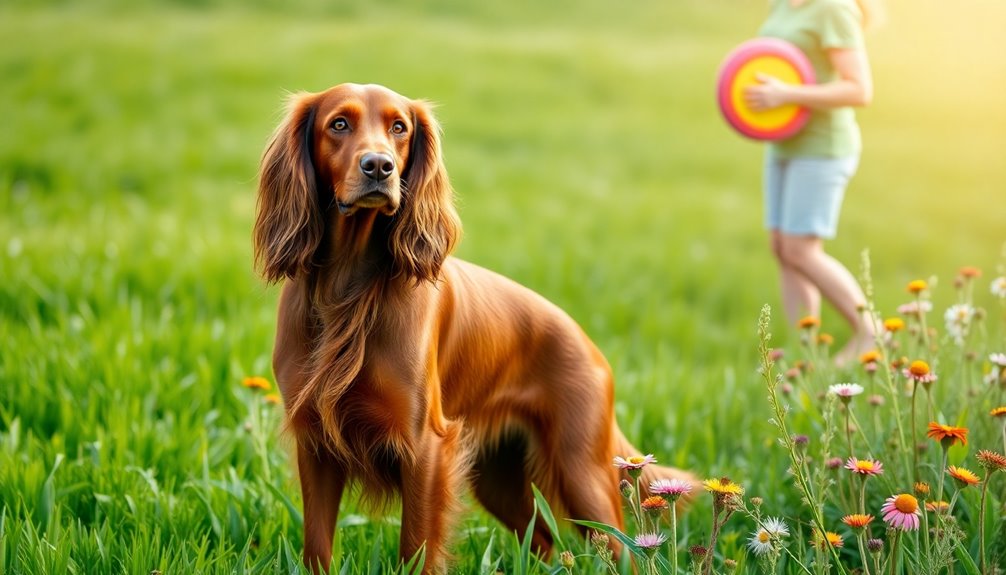
Regular training and exercise are essential for keeping your Irish Setter happy and healthy. With their high energy levels, you'll need to provide at least 30 to 60 minutes of exercise daily to prevent boredom-related behaviors.
Here are three key areas to focus on:
- Training and Socialization: Start early with training and socialization to help your Irish Setter develop good behavior. They can be exuberant, so consistent and positive reinforcement techniques work best.
- Exercise: Engage in various activities like walking, running, or playing fetch. This not only satisfies their exercise needs but also reinforces your bond.
- Mental Stimulation: Incorporate agility training and obedience classes to enhance their focus. Short, positive training sessions keep them engaged and help mitigate excessive playfulness.
Living Environment Adaptability

Irish Setters are lively dogs that flourish in active households where they've plenty of space to run and play. These energetic dog breeds thrive when given at least 30-60 minutes of daily physical activity, making them well-suited for homes with large yards or easy access to open areas.
While they can adapt to apartment living with proper training, you'll find that their playful nature requires regular outdoor activities to keep boredom at bay. In a confined living environment, they may develop separation anxiety or exhibit behavioral issues if not sufficiently stimulated.
Thankfully, Irish Setters are easy to train, and consistent socialization can help manage their exuberance, especially in shared spaces. They generally don't bark excessively, but without enough physical and mental engagement, they might become restless.
If you're considering bringing an Irish Setter into your home, guarantee your lifestyle aligns with their high energy needs. They need ample opportunities to explore and play, so think about how you can provide them with the space and activities they crave.
Your commitment to their physical and mental well-being will help them thrive in your living environment.
Family Compatibility
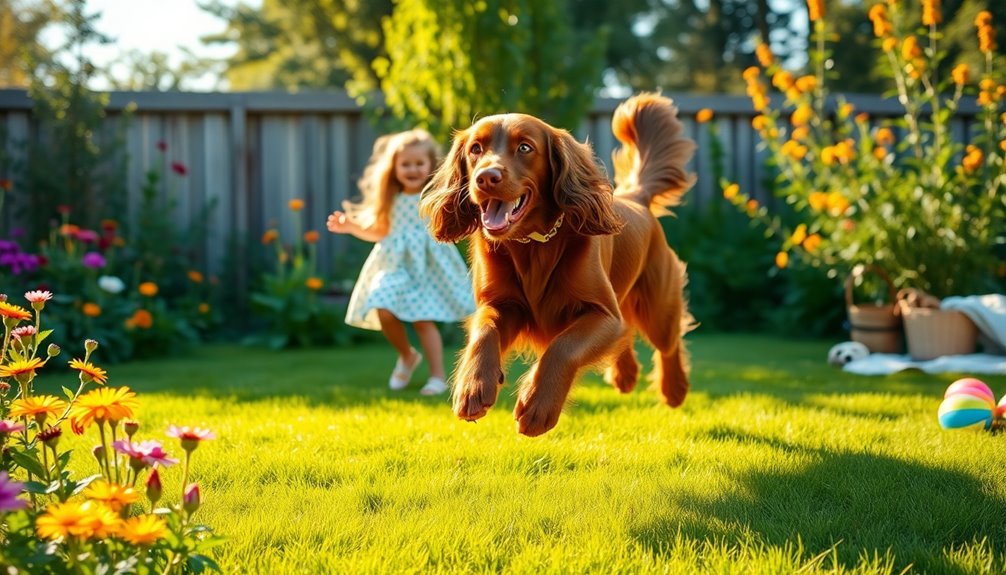
Families looking for a playful and affectionate companion often find that Irish Setters fit the bill perfectly.
These dogs are known for their friendly and outgoing temperament, making them great additions to a loving home. Their energetic nature means they thrive in active households, where they can engage in play and outdoor activities.
Here are three reasons why Irish Setters are family-friendly:
- Good with Children: They typically get along well with kids, adding joy to your home. However, their exuberance may lead to rambunctious behavior, so supervision around small children is vital.
- Social and Friendly: Irish Setters have a sociable disposition, allowing them to get along with strangers and other pets, fostering a harmonious environment.
- Significance of Early Socialization: To guarantee your Irish Setter develops good manners, early socialization and training are essential.
This will help them adapt well to family life and interact positively with all members.
Ethical Breeding and Adoption

When considering adding an Irish Setter to your family, it's important to focus on ethical breeding and adoption practices. Prioritizing adoption from rescue organizations or shelters not only provides homes for Irish Setters in need but also emphasizes the significance of giving these dogs a second chance.
If you choose to go the breeding route, selecting reputable Irish Setter breeders who follow ethical practices is imperative. Responsible breeders conduct health screenings to guarantee the well-being of their puppies, which can greatly impact the longevity and quality of life of your future companion.
Avoiding support for unethical breeding practices is essential, as it helps prevent health risks associated with poor breeding. Ethical breeders create a supportive environment for their puppies, making sure they're well-socialized and ready for their future homes.
Frequently Asked Questions
Which Setter Is the Calmest?
If you're looking for the calmest setter, the English Setter is your best bet.
They're known for their gentle, easygoing nature, making them great companions, especially for families and kids.
While all setters need regular exercise, the English Setter tends to have lower energy levels, allowing them to relax indoors.
If you prefer a more laid-back dog that still enjoys playtime, the English Setter fits the bill perfectly.
What Are the Two Types of Irish Setters?
Think of the two types of Irish Setters like vibrant colors on an artist's palette.
You've got the Irish Red Setter, boasting a striking solid red coat, bred mainly for hunting and fieldwork.
Then there's the Irish Red and White Setter, with its eye-catching red and white coat, traditionally used for pointing game birds.
Both types share similar physical traits, making them equally charming companions.
Each brings unique qualities to the world of dog lovers!
Why Are Irish Setters Not Popular Anymore?
Irish Setters aren't as popular anymore primarily due to their high energy levels and exercise needs, which can be tough for urban families.
Their rambunctious nature makes them less appealing for those with small children.
Plus, the breed faces stiff competition from other gundogs that are easier to train.
Health concerns like hip dysplasia and bloat also deter potential owners, as do changing hunting preferences favoring more versatile breeds.
What Are the Downsides of Irish Setters?
Owning an Irish Setter is like dancing with a whirlwind; it's exhilarating but can be challenging. Their high energy demands at least 30-60 minutes of exercise daily, making them unsuitable for couch potatoes.
They might also exhibit rambunctious behavior around small children or delicate pets, requiring close supervision.
Plus, their long coats need daily grooming to prevent matting.
Finally, they can suffer from separation anxiety, leading to destructive habits if left alone too long.
Conclusion
In choosing an Irish Setter, you're not just getting a dog; you're welcoming a joyful companion into your life. Their playful spirit and loving nature can unexpectedly turn a quiet evening into a lively adventure. Imagine coming home after a long day, only to be greeted by that enthusiastic wagging tail. With the right care and training, these graceful dogs will fill your days with laughter and love, making every moment with them truly special.


